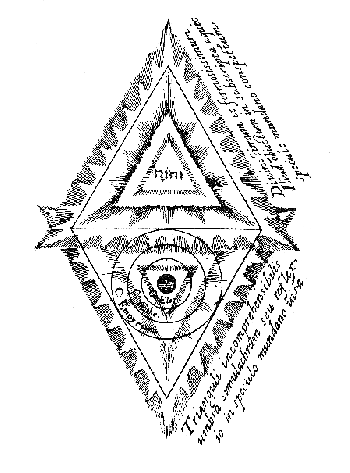The Santa Fe Institute logo, together with the previous post,
suggests a review of Whirligig and Quaternion for Goldstein.
Wednesday, June 24, 2015
Logos
Thursday, October 21, 2010
Problem Picture

The above image was suggested by yesterday's
Celebration of Mind and by Plan 9 From Outer Space
in yesterday's New York Times and in this journal.
Wednesday, April 23, 2008
Wednesday April 23, 2008
Upscale Realism
or, "Have some more
wine and cheese, Barack."
Allyn Jackson on Rebecca Goldstein
in the April 2006 AMS Notices (pdf)
|
"Rebecca Goldstein’s 1983 novel The Mind-Body Problem has been widely admired among mathematicians for its authentic depiction of academic life, as well as for its exploration of how philosophical issues impinge on everyday life. Her new book, Incompleteness: The Proof and Paradox of Kurt Gödel, is a volume in the 'Great Discoveries' series published by W. W. Norton….
In March 2005 the Mathematical Sciences Research Institute (MSRI) in Berkeley held a public event in which its special projects director, Robert Osserman, talked with Goldstein about her work. The conversation, which took place before an audience of about fifty people at the Commonwealth Club in San Francisco, was taped…. A member of the audience posed a question that has been on the minds of many of Goldstein’s readers: Is The Mind-Body Problem based on her own life? She did indeed study philosophy at Princeton, finishing her Ph.D. in 1976 with a thesis titled 'Reduction, Realism, and the Mind.' She said that while there are correlations between her life and the novel, the book is not autobiographical…. She… talked about the relationship between Gödel and his colleague at the Institute for Advanced Study, Albert Einstein. The two were very different: As Goldstein put it, 'Einstein was a real mensch, and Gödel was very neurotic.' Nevertheless, a friendship sprang up between the two. It was based in part, Goldstein speculated, on their both being exiles– exiles from Europe and intellectual exiles. Gödel's work was sometimes taken to mean that even mathematical truth is uncertain, she noted, while Einstein's theories of relativity were seen as implying the sweeping view that 'everything is relative.' These misinterpretations irked both men, said Goldstein. 'Einstein and Gödel were realists and did not like it when their work was put to the opposite purpose.'" |
Related material:
From Log24 on
March 22 (Tuesday of
Passion Week), 2005:
|
"'What is this Stone?' Chloe asked…. 'It is told that, when the Merciful One made the worlds, first of all He created that Stone and gave it to the Divine One whom the Jews call Shekinah, and as she gazed upon it the universes arose and had being.'"
— Many Dimensions,
For more on this theme
appropriate to Passion Week — Jews playing God — see
Rebecca Goldstein
Wine and cheese |
From
UPSCALE,
a website of the
physics department at
the University of Toronto:
|
Mirror Symmetry

"The image [above]
The caption of the
'That most divine and beautiful
The caption of the
'A shadow, likeness, or * Sic. The original is incomprehensibilis, a technical theological term. See Dorothy Sayers on the Athanasian Creed and John 1:5. |
For further iconology of the
above equilateral triangles,
see Star Wars (May 25, 2003),
Mani Padme (March 10, 2008),
Rite of Sping (March 14, 2008),
and
Art History: The Pope of Hope
(In honor of John Paul II
three days after his death
in April 2005).
Happy Shakespeare's Birthday.


